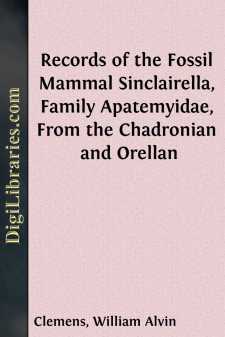Categories
- Antiques & Collectibles 13
- Architecture 36
- Art 48
- Bibles 22
- Biography & Autobiography 813
- Body, Mind & Spirit 142
- Business & Economics 28
- Children's Books 17
- Children's Fiction 14
- Computers 4
- Cooking 94
- Crafts & Hobbies 4
- Drama 346
- Education 46
- Family & Relationships 57
- Fiction 11829
- Games 19
- Gardening 17
- Health & Fitness 34
- History 1377
- House & Home 1
- Humor 147
- Juvenile Fiction 1873
- Juvenile Nonfiction 202
- Language Arts & Disciplines 88
- Law 16
- Literary Collections 686
- Literary Criticism 179
- Mathematics 13
- Medical 41
- Music 40
- Nature 179
- Non-Classifiable 1768
- Performing Arts 7
- Periodicals 1453
- Philosophy 64
- Photography 2
- Poetry 896
- Political Science 203
- Psychology 42
- Reference 154
- Religion 513
- Science 126
- Self-Help 84
- Social Science 81
- Sports & Recreation 34
- Study Aids 3
- Technology & Engineering 59
- Transportation 23
- Travel 463
- True Crime 29
Records of the Fossil Mammal Sinclairella, Family Apatemyidae, From the Chadronian and Orellan
Categories:
Description:
Excerpt
Description and comments.—P4 of KU no. 11210 has a large posterolingual cusp separated from the main cusp by a distinct groove, which deepens posteriorly. The posterolingual cusp is supported by the broad posterior root. P4 of the type specimen of Sinclairella dakotensis is described (Jepsen, 1934, p. 392) as having an oval outline at the base of the crown, and a small, posterolingual cusp. A chip of enamel is missing from the posterior slope of the main cusp of the P4 of KU no. 11210. The anterior slope of the main cusp is flattened, possibly the result of wear, and there is no evidence of a groove like that present on the P4 of the type specimen.
Only a few differences were found between the molars preserved in KU no. 11210 and their counterparts in the type specimen. A stylar shelf is present labial to the metacone of M1 of KU no. 11210, but, unlike the type, its surface is smooth and there is no evidence of cusps. Of the three small stylar cusps on the stylar shelf of M2 the smallest is in the position of a mesostyle. The M2 lacks a chip of enamel from the lingual surface of the hypocone. Unlike the M2 of Princeton no. 13585, in occlusal view the posterior margin of the M2 of KU no. 11210 is convex posterior to the metacone. The anterior edge of the base of the zygomatic arch of KU no. 11210 was dorsal to M2. The shallow oval depression in the maxillary dorsal to M1 might be the result of post-mortem distortion.
The molars preserved in KU no. 11210 and their counterparts in the type specimen do not appear to be significantly different in size (table 1) or morphology of the cusps. The only difference between the two specimens that might be of classificatory significance is the difference in size of the posterolingual cusp of P4. At present the range of intraspecific variation in the morphology of P4 has not been documented for any species of apatemyid. The evolutionary trend or trends of the apatemyids (McKenna, 1960, p. 48) for progressive reduction of function of p4 probably were paralleled by similar trends in the evolution of the P4. If so, the intraspecific variation in the morphology of P4 could be expected to be somewhat greater than that of the upper molars, for example. The morphological difference between the P4's of the type of Sinclairella dakotensis and KU no. 11210 is not extreme and does not exceed the range of intraspecific variation that could be expected for this element of the dentition. The close resemblances in size and morphology between the M1-2 of Princeton no. 13585 and KU no. 11210 also favor identification of the latter as part of a member of an Orellan population of Sinclairella dakotensis.
Weld County, northeastern Colorado
Fig. 2. Sinclairella dakotensis Jepsen, UCM no. 21073, right M2; Orellan, Weld County, Colorado; drawing by Mrs. Judith Hood: occlusal view, approximately × 9.
Material.—UCM no. 20173 (fig. 2), is a right M2.
Locality and stratigraphy.—The tooth was discovered at the Mellinger locality, Sec. 17, T 11 N, R 65 W, Weld County, Colorado....


